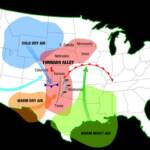How long does a tornado last?
Tornadoes can last from several seconds to more than an hour. The longest-lived tornado in history is really unknown, because so many of the long-lived tornadoes reported from the early-mid 1900s and before are believed to be tornado series instead. Most tornadoes last less than 10 minutes.
Do tornadoes really skip?
Not in a literal sense, despite what you may have read in many older references, news stories, or even damage survey reports. By definition (above), a tornado must be in contact with the ground. There is disagreement in meteorology over whether or not multiple touchdowns of the same vortex or funnel cloud mean different tornadoes (a strict interpretation). In either event, stories of skipping tornadoes usually mean
- There was continuous contact between vortex and ground in the path, but it was too weak to do damage.
- Multiple tornadoes happened; but there was no survey done to precisely separate their paths (very common before the 1970s)
- There were multiple tornadoes with only short separation, but the survey erroneously classified them as one tornado.
How do tornadoes dissipate?
The details are still debated by tornado scientists. We do know tornadoes need a source of instability (heat, moisture, etc.) and a larger-scale property of rotation (vorticity) to keep going. There are a lot of processes around a thunderstorm which can possibly rob the area around a tornado of either instability or vorticity. One is relatively cold outflow -- the flow of wind out of the precipitation area of a shower or thunderstorm. Many tornadoes have been observed to go away soon after being hit by outflow. For decades, storm observers have documented the death of numerous tornadoes when their parent circulations (mesocyclones) weaken after they become wrapped in outflow air -- either from the same thunderstorm or a different one. The irony is that some kinds of thunderstorm outflow may help to cause tornadoes, while other forms of outflow may kill tornadoes.
Where and when do tornadoes occur?
Tornadoes occur in many parts of the world, including Australia, Europe, Africa, Asia, and South America. Even New Zealand reports about 20 tornadoes each year.Two of the highest concentrations of tornadoes outside the U.S. are Argentina and Bangladesh. Both have similar topography with mountains helping catch low-level moisture from over Brazil (Argentina) or from the Indian Ocean (Bangladesh). About 1,000 tornadoes hit the U.S. yearly. Since official tornado records only date back to 1950, we do not know the actual average number of tornadoes that occur each year. Plus, tornado spotting and reporting methods have changed a lot over the last several decades. Tornado season usually refers to the time of year where the U.S. sees the most tornadoes. The peak “tornado season” for the southern plains -- often referred to as Tornado Alley -- is during May into early June. On the Gulf coast, it is earlier during the spring. In the northern plains and upper Midwest, tornado season is in June or July. But, remember, tornadoes can happen at any time of year. Tornadoes can also happen at any time of day, but most tornadoes occur between 4-9 p.m.
Image courtesy of NOAA
© 2010 Naturesfury.net


Info courtesy of NOAA
Tornado Alley is a nickname for an area that consistently experiences a high frequency of tornadoes each year. The area that has the most strong and violent tornadoes includes eastern SD, NE, KS, OK. Northern TX, and eastern Colorado. The relatively flat land in the Great Plains allows cold dry polar air from Canada to meet warm moist tropical air from the Gulf of Mexico. A large number of tornadoes form when these two air masses meet, along a phenomenon known as a "dryline."
The dryline is a boundary separating hot, dry air to the west from warm, moist air to the east. You can see it on a weather map by looking for sharp changes in dew point temperatures. Between adjacent weather stations the
differences in dew point can vary by as much as 40 degrees or more. The dryline is usually found along the western high plains. Air moving down the eastern slopes of the Rockies warms and dries as it sinks onto the plains, creating a hot, dry, cloud-free zone. During the day, it moves eastward mixing up the warm moist air ahead of it. If there is enough moisture and instability in the warm air, severe storms can form - because the dryline is the "push" the air needs to start moving up! During the evening, the dryline "retreats" and drifts back to the west. The next day the cycle can start all over again, until a larger weather system pushes through and washes it away.
What is a waterspout?
A waterspout is a tornado over water -- usually meaning non-supercell tornadoes over water. Waterspouts are common along the southeast U.S. coast -- especially off southern Florida and the Keys -- and can happen over seas, bays and lakes worldwide. Although waterspouts are always tornadoes by definition; they don't officially count in tornado records unless they hit land. They are smaller and weaker than the most intense Great Plains tornadoes, but still can be quite dangerous. Waterspouts can overturn boats, damage larger ships, do significant damage when hitting land, and kill people. The National Weather Service will often issue special marine warnings when waterspouts are likely or have been sighted over coastal waters, or tornado warnings when waterspouts can move onshore.
Tornado Facts

